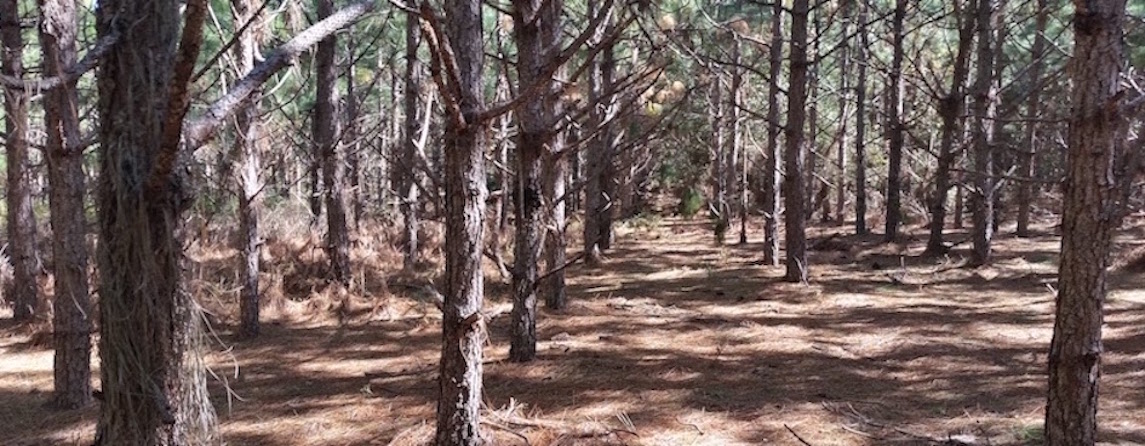New Report: “Real” vs. “Fake” Forests: Why Tree Plantations Are Not Forests
 Loblolly Pine Plantation, South Carolina, USA. Photo: Petermann
Loblolly Pine Plantation, South Carolina, USA. Photo: Petermann
In the attached report “Real” vs. “Fake” Forests: Why Tree Plantations Are Not Forest,” Dominick A DellaSala discusses in detail the reasons why industrial tree plantations cannot be considered forests, and how the expansion of tree plantations to meet rising demands for wood is leading to the destruction of native forests.
This is a key point, and one that backs up data collected by the UN Food and Agriculture Organization. It directly contradicts the position of the timber industry and companies like ArborGen, which specialize in genetically engineered and hybrid “purpose-grown trees.” They argue that we need fast growing plantations to meet rising wood demands and take the pressure off of native forests. This report points out how exactly the opposite is what is really happening on the ground. It goes on to point out that drastically reducing the demand for wood products is one REAL way to protect forests.
While common sense would seem to dictate that industrial tree plantations and forests are very different things, it is amazing the otherwise intelligent-seeming people who have argued with me that you cannot differentiate between them. Of course, most of them had money in the game which does tend to skew logic. This report, on the other hand provides very cogent arguments backed up by interesting research.
In the report, DellaSala opens by explaining his position that “Tree Plantations Are Not Forests”
Is a forest merely a collection of trees forming a canopy overstory (i.e., tree cover)? If we plant trees, does that make it a forest? How much of the Earth’s forests is planted (more correctly termed “tree farms”)? How do planted forests differ from native forests? Can we meet wood demands while minimizing our ecological footprint?
To begin, when it comes to a forest, we each see what we want.
A forester sees a crop of trees to be extracted for timber-profit as soon as possible—the economic bottom line. An ecologist sees an ecosystem where the parts are interwoven and uniquely sculpted by natural processes; deforestation is antithetical to the sum-of-the parts.
When I take a hike into a native (unlogged) forest, I see a rich tapestry of life. This intimidate dance of plant and animal, form and function, process and outcome is lacking in a plantation, especially plantations embedded in a sea of industrialized forestry. A walk in an industrial landscape has a different feel, smell, and much fewer dance partners. Wally Menne, a member of the Timberwatch coalition (https://www.timberwatch.org.za), aptly calls timber plantations “fake” forests (https://wrm.org.uy/oldsite/ countries/SouthAfrica/difference.html). I adopt his terminology to distinguish real from fake, native from plantation, natural from engineered. In science, terminology matters—in this case, do we see forests as living, self-willed ecosystems or a crop to be manipulated for the bottom line?
His abstract usefully summarizes the content of the report:
Tree plantations make up some 4% of the world’s forests and are increasing as native forests are cut down to meet rising wood product demands. An additional 30% of the world’s forests are in “production,” as defined by the Food and Agriculture Organization (FAO) of the United Nations. Compared to native (“real”) forests, plantations (“fake”) are often characterized by genetically modified tree genomes, over simplified forest structures (deficient in snags, down wood, large trees, and understory vegetation), single species monocultures, and greatly altered ecosystem processes (e.g., natural disturbances, hydrology, nutrient cycling, pollination, and food-web dynamics). Existing plantations can be managed to improve ecological integrity by enhancing structures otherwise absent in intensively managed systems. Conversion of native forests to plantations, however, needs to cease along with reducing wasteful consumption, increasing reliance on alternative wood fibers (e.g., hemp), recycling, and the use of engineered wood products that do not come from native forests.
As we ramp up the global fight to stop the development of genetically engineered tree plantations, and even the unprecedented release of GE trees into wild forest ecosystems, as researchers propose here in the US, this report provides some very useful data.
–Anne Petermann, Coordinator, Campaign to STOP GE Trees
Download the PDF of the report here: DellaSala2019fakeforests
